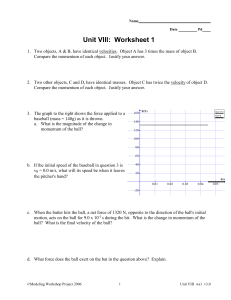
Given: m ball = 46 g = 0.046 kg m cannon = 1.35 kg v cannon = -2.1 m/s If the cannon recoils with a speed of 2.1 m/s, determine the muzzle speed of the tennis ball. A 46-gram tennis ball is launched from a 1.35-kg homemade cannon. Thus, the collision must have resulted in a 53-unit impulse since it altered the object's momentum by 53 units.Ħ0. The collision with the wall changed the object's momentum from +38 units to -15 units. The "-" sign is used since the object is now moving in the opposite direction as the original motion. The -15 is the product of mass (3 kg) and velocity (-5 m/s). Upon rebounding, the object has a momentum of -15 units (kg A final impulse is encountered when colliding with a wall. Since this impulse acts in the direction of motion, it changes the object's momentum from 18 units to 38 units. This is equivalent to an impulse of 20 units (N The object encounters a force of 2.5 N for 8.0 seconds. Here the object begins with a momentum of 18 units (kg Like the previous problem, this problem is best solved by thinking through it conceptually using the impulse-momentum change principle. Determine the impulse delivered by the wall to the object. The object then collides head-on with a wall and heads in the opposite direction with a speed of 5.0 m/s. The object then encounters a force of 2.5 N for 8.0 seconds in the direction of its motion. A 3.0-kg object is moving forward with a speed of 6.0 m/s. Since momentum is the product of mass and velocity, the velocity can be easily determined. The question asks for the object's velocity after encountering these two impulses. Since this impulse is "resistive" in nature, it will decrease the object's momentum by 48 units. This is equivalent to an impulse of 48 units (N The object then encounters a resistive force of 6.0 N for 8.0 s.

If the impulse is in the direction of an object's motion, then it will increase the momentum. A 60-unit impulse will change the momentum by 60 units, either increasing or decreasing it. It then encounters an impulse of 60 units (N This question is best thought about conceptually using the principle that an objects momentum is changed when it encounters an impulse and the amount of change in momentum is equal to the impulse which it encounters. Determine the final velocity of the object.

A resistive force of 6.0 N then impedes its motion for 8.0 seconds.

A 4.0-kg object has a forward momentum of 20. So if impulse is known and time is known, force can be easily determined.į = Impulse/t = (-16.7 N s) / (0.100 s) = -167 Nĥ8. (b) The impulse is the product of force and time. Where the "-" indicates that the impulse was opposite the original direction of motion. (a) determine the impulse with the wall, (b) determine the force of the wall on the ball.Īnswer: Answer: (a) -16.7 N s (b) -167 N A 0.530-kg basketball hits a wall head-on with a forward speed of 18.0 m/s. Momentum and Collisions - Home || Printable Version || Questions with LinksĪnswers to Questions: All || #1-5 || #6-36 || #37-56 || 57-72ĥ7.

The Review Session » Momentum and Collisions » Answers Q#57-72 Momentum and Collisions Review


 0 kommentar(er)
0 kommentar(er)
